Operation & Maintenance of RWH Systems
This section describes common maintenance works required to look after your RWH tank well. Appendix A [Word Document – 58.0KB] contains a Maintenance Record Sheet for you to fill out and keep.
REMEMBER, THAT YOUR RWH SYSTEM BELONGS TO YOU. IT WILL ONLY GIVE, CLEAN & SAFE WATER IF YOU LOOK AFTER IT…
 Figure 1 A: A poorly maintained rainwater tank is unhealthy people! |  Figure 1 B: A well maintained rainwater tank is healthy people! |
1. RWH System Maintenance Requirements
| Component | Task | Frequency |
|---|---|---|
| Roof | Clean and/or wash off roof to remove dust/dirt/leaves, etc. If using water, divert roof runoff away from the tank inlet during cleaning. | At least 2-3 times/year, especially prior to the monsoon, after a long period of dry weather and after strong winds. |
| Trim/cut trees around the house, especially any branches overhanging the roof. Fig. 2A | When required. | |
| Paint (with lead free paint) or replace any rusty roofing. | When required. | |
| Fix any holes in roof to maximise rainfall capture. | When required. | |
| Downpipe | Check downpipe inlet and remove any dirt, leaves, etc. If using water, divert roof runoff away from the tank inlet during cleaning. | At least 2-3 times/year, especially prior to the monsoon, after a long period of dry weather and after strong winds. |
| Repair holes or replace screen at downpipe inlet (if present). | When required. | |
| Ensure there are no gaps at downpipe entrance for mosquitoes to enter. | When required. | |
| Repair leaks at elbows/joints. | When required. | |
| First flush downpipe | Remove plug manually to drain first flush water. Replace securely. Fig. 2C | After each rain event. |
| Filters | Clean media filter, by removing media (Appendix B) and washing thoroughly. Fig. 2 D | At least thrice a year, prior to every wet season. |
| Replace filter media when exhausted or when the filter is overflowing more than normal. | When required – generally every 1-2 years, except for charcoal which should be replaced every 6-12 months. | |
| Check and replace any damaged/broken cloth filters or mosquito proof netting to ensure effective filtering. | At least twice per year, prior to every wet season. | |
| Tank | Clean tank, removing any silt/sediment. Fig. 2 F | At least once a year, prior to every wet season (see Appendix D) |
| Check for and repair any leaks. Fig 2 E | When required. | |
| Disinfect. | If /When required. | |
| Check water level in tank using a by feeling the tank surface for changes in temperature, or tapping the tank for changes in sound. Opening the lid is not recommended to determine the water level, as it may allow dust/dirt/pests to enter the tank. | When required; more frequently during dry season. (Note: It is recommended not to leave the tank empty as the sun’s heat can make tiny cracks in the walls. For this reason, it’s also better if you can shade the tank from direct sunlight.) |
|
| Ensure lid is in place, steady and secure to prevent mosquitoes and animals from entering. | When required. | |
| Overflow and bottom drain | Ensure there are no gaps in overflow/bottom drain covers/netting, where mosquitoes can enter/exit. | When required. |
| Repair or replace damaged netting/covers. | When required. | |
| Taps | Repair or replace any leaking taps. | When required. |
| Remove any water ponding by tap. | When required. | |
| Consider fitting a lock to the tap to prevent children from playing with it | When required. |
Figure 2: Some Regular Operation and Maintenance Tasks
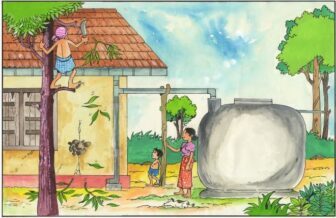 A. Trimming/cutting branches from trees near the house | 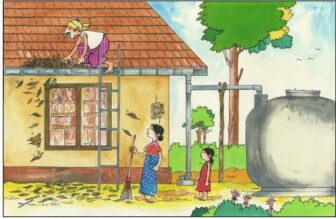 B. Cleaning out the gutters |
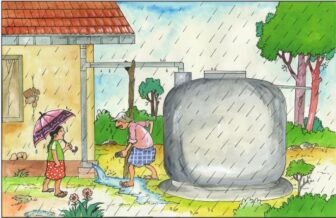 C. Doing the first flush! | 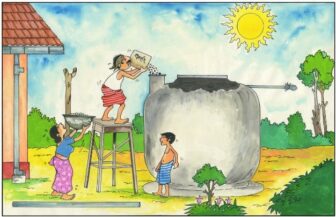 D. Replacing the filter media. |
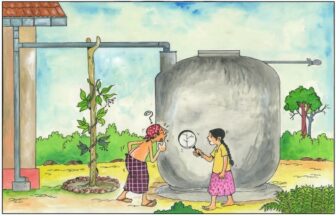 E. Checking for cracks. | 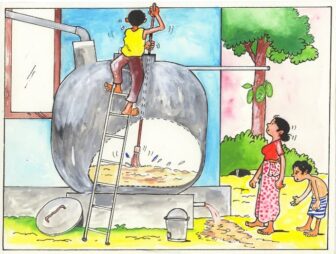 F. Cleaning out the tank. |
2. Fixing Problems
This section lists a number of common RWH system problems, their likely causes and possible solutions. Supporting information is provided in the following appendices:
- Appendix C: Repairs Record Sheet – This document provides a table for you to fill in listing any repairs you have to undertake of your RWH system. (Word Document, 48kb)
- Appendix D: Tank Cleaning and Chlorine Disinfection using Household Bleach – This provides you with instructions for how to clean and disinfect your tank.
- Appendix E: RWH System Sanitary Survey – This provides you with a sanitary survey form to assess how well you are looking after your RWH system and to help find sources of contamination affecting the quality of your rainwater. (Word Document, 53kb)
Common RWH System Problems, Causes and Solutions
| Problem | Cause | Solution(s) |
|---|---|---|
| Water is not entering tank | Downpipe is blocked. | Check the downpipe and remove any blockages. |
| First flush device has not been reconnected to tank. | Reconnect first flush device to tank. | |
| First flush downpipe plug not replaced. | Fit removable plug to seal first flush downpipe. | |
| Filter is blocked. | Clean out filter. Replace filter media if necessary. | |
| Filter overflows during heavy rain | Some overflowing during very heavy rain is normal as the filter has a limited capacity. If frequent overflowing occurs, the filter may be blocked and need cleaning or replacement. | Remove filter media and wash/scrub to remove accumulated solids. Replace filter media if necessary. If this does not solve the problem, consider replacing the filter media with larger sized particles. However, this will result in some reduction in water quality. If you are not using the rain water for drinking, this may be acceptable to you. Otherwise, you should disinfect any water used for drinking. |
| Tank is leaking but no hole/ crack is visible | Poor construction (e.g. use of wrong cement mixture, insufficient curing) | Seek help from LRWHF mason or other suitably qualified person . |
| Wash out is leaking | Check and tighten the wash out pipe. | |
| Algal growth inside tank. | Light is entering the tank allowing algae to grow. | Ensure the tank and filter lids are in place. Seal any gaps between these lids and the tank to prevent light entering, as for “mosquito entry” below. Clean tank, removing algal growth. |
| Mosquitoes are breeding inside tank | Mosquitoes are entering tank through: • lid • downpipe • filter • overflow | Ensure the tank lids is in place. Seal any gaps between the lids Install, repair or replace mosquito netting in the filter. Don’t cover the pipe entering the filter with polythene as this will stop water entering the filter. Install repair or replace netting around the overflow pipe and bottom drain outlet. Don’t use polythene on the overflow as this will stop it from working and the tank from being vented. |
| Water contains suspended particles | Filter contains no media. | Check filter media and add or replace as necessary. |
| Possible algal growth inside tank | See above. | |
| Excessive silt/sediment in bottom of tank | Remove silt/sediment by draining tank contents (storing the water for reuse if possible), clean and remove silt/sediment manually and then refill. Refer Appendix D for details. | |
| Water is discoloured, smells or tastes bad | Dead animals/birds or animal/human waste, including bird droppings on roof, in gutter or in tank. | Remove any dead birds/animals from roof, gutters and tank. Disinfect with chlorine as set out in Appendix D. Leave the tank for 24h before using any water. |
| Accumulated organic matter on roof/gutter (leaves, etc.) | Clean roof/gutter as required. To clean the water, it can be filtered through crushed charcoal, coconut fibre or sand. | |
| Excessive silt/sediment in tank. | As above. | |
| Animal or human waste, including bird droppings, have entered the tank. | ||
| Tank may have been contaminated by person entering tank to do repairs or maintenance. |
